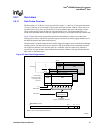
104 Hardware Reference Manual
Intel
®
IXP2800 Network Processor
Intel XScale
®
Core
3.6.3.3.1 Global Clean and Invalidate Operation
A simple software routine is used to globally clean the data cache. It takes advantage of the line-
allocate data cache operation, which allocates a line into the data cache. This allocation evicts any
cache dirty data back to external memory. Example 22 shows how data cache can be cleaned.
The line-allocate operation does not require physical memory to exist at the virtual address
specified by the instruction, since it does not generate a load/fill request to external memory. Also,
the line-allocate operation does not set the 32 bytes of data associated with the line to any known
value. Reading this data will produce unpredictable results.
The line-allocate command will not operate on the mini Data Cache, so system software must clean
this cache by reading two Kbytes of contiguous unused data into it. This data must be unused and
reserved for this purpose so that it will not already be in the cache. It must reside in a page that is
marked as mini Data Cache cacheable.
The time it takes to execute a global clean operation depends on the number of dirty lines in cache.
Example 22. Global Clean Operation
; Global Clean/Invalidate THE DATA CACHE
; R1 contains the virtual address of a region of cacheable memory reserved for
; this clean operation
; R0 is the loop count; Iterate 1024 times which is the number of lines in the
; data cache
;; Macro ALLOCATE performs the line-allocation cache operation on the
;; address specified in register Rx.
;;
MACRO ALLOCATE Rx
MCR P15, 0, Rx, C7, C2, 5
ENDM
MOV R0, #1024
LOOP1:
ALLOCATE R1 ; Allocate a line at the virtual address
; specified by R1.
ADD R1, R1, #32 ; Increment the address in R1 to the next cache line
SUBS R0, R0, #1 ; Decrement loop count
BNE LOOP1
;
;Clean the Mini-data Cache
; Can’t use line-allocate command, so cycle 2KB of unused data through.
; R2 contains the virtual address of a region of cacheable memory reserved for
; cleaning the Mini-data Cache
; R0 is the loop count; Iterate 64 times which is the number of lines in the
; Mini-data Cache.
MOV R0, #64
LOOP2:
LDR R3,[R2],#32 ; Load and increment to next cache line
SUBS R0, R0, #1 ; Decrement loop count
BNE LOOP2
;
; Invalidate the data cache and mini-data cache
MCR P15, 0, R0, C7, C6, 0
;


















